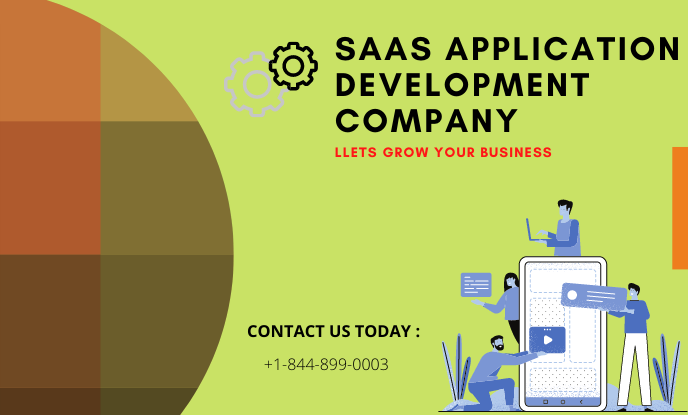SaaS solutions are extremely valuable to the people that utilize them. One of the primary benefits is that all of the data generated is stored in the cloud, where it can be maintained safely and securely. Additionally, it keeps you away from the expenditures of hardware purchases and updates, as well as the costs of management and operations.
Furthermore, the SaaS solution enables the chosen person to access the designated data from any place at their discretion. Furthermore, SaaS providers provide higher levels of security than can be provided by organizations in-house.
As a result, we can state that “SaaS solutions offer a fantastic solution with significant benefits to firms who are dealing with traditional in-house systems.”
SaaS (Software as a Service) is quickly increasing in a variety of businesses these days. Many entrepreneurs and developers are entering the SaaS Application Development company field in order to address difficulties at the enterprise level.
The development of SaaS applications, whether for external or internal usage, follows a certain Life Cycle.
And each piece of the Cycle is crucial to the development of a product that is successful, helpful, and visually appealing, whether it is for internal or external clients.
Saas Development
According to industry analysts, SaaS development is one-of-a-kind. It necessitates a certain skill set as well as an open-minded attitude.
The following are some advantages of adopting a SaaS:
- Lower costs. Given that SaaS is a “cloud” solution, the costs that clients must pay are far cheaper than those for on-premise solutions.
- Scalability. Because SaaS is a pre-developed solution, users do not have to put much effort into planning because SaaS is very scalable.
- Upgrades. Because SaaS handles all of the changes on its own, it is quite convenient for the consumers to do so.
- Integration. Platforms as a service (SaaS) are ideal for integrating with other applications.
- User Experience. SaaS solutions are always striving to make their user experience delightful. As a result, its clients may save time by not having to learn how to utilize the program.
The SaaS Development Life Cycle Must Begin with a Vision
If you want to create a fantastic tool, you will need to put a lot of effort into research. Identifying the requirements of an organization is the first step in meeting those requirements.
Following the process of gathering ideas and assessing the market, you will have a concept of a product that will be both beneficial and successful.
The Planning Stage
You can’t do much in the development of a SaaS Application unless you have a solid plan. You and your development authority must be clear on how you want to create your SaaS, how much it will cost when you expect to be ready to launch it, and what your marketing plan will look like.
You may find that Software Development Strategies for your SaaS solution is beneficial in answering those queries.
The Subscription Stage
After all of the decisions about pricing and architecture have been made, the moment has come to select a cloud computing provider to work with. However, while there are numerous options to be taken when selecting a SaaS platform for your business, the cloud provider pick is arguably the most crucial.
The Development Stage
The development stage is a difficult period to navigate. There are several architectural considerations to be made in the course of the project’s development.
In reality, there is no purpose in designing a SaaS application unless it is adequate for all of the intended users and has the ability to grow in scope and functionality.
Some of the most important characteristics that a SaaS development must achieve in order to be regarded beneficial for customers as well as lucrative for developers are outlined in the following section:
- User Experience. The programme must be simple to use and intuitive to navigate.
- Security. SaaS applications must provide a high degree of security, and their clients must have confidence in the outstanding protection of their data stored on the platform.
- Customer Support. A SaaS application must have built-in support mechanisms, 24-hour access, and regular, non-disruptive upgrades.
The SaaS development process will look like this if you keep these key rules in mind:
Selection of a Development Methodology
There are several approaches available that are referred to as the “Software Development Lifecycle.” Let’s take a look at a few of the more prevalent ones:
- Rapid – put together fast to speed up development and then tested.
- Spiral – Here, development is separated into cycles, each of which is reviewed in order to enhance the approach and impact the following cycle.
- Agile is a development process in which each iteration is reviewed after it is completed, allowing for positive changes and plan adaptations before the next iteration begins.
SaaS Will Mean HTML5
HTML5 technology is required for new products. It is one of the most appropriate for today’s climate. Because this technology creates powerful Internet apps, it eliminates the requirement for old plugins.
“When Microsoft announced in 2014 that it would be ending support for Windows XP, Microsoft platforms that couldn’t support HTML5 started to fade away.”
However, there may still be some bugs with HTML5 on mobile devices, but they are becoming less common by the day. If there are any problems, a native mobile app could be the best option.
SaaS and Stateless Architecture
Because stateless design enables smooth performance, flexibility, scalability, and fault tolerance, it is chosen. Because stateless apps don’t need to reserve storage for prior requests, the cost is reduced.
These apps can also quickly grow, making them ideal for coping with use surges. Stateful architecture, on the other hand, necessitates more administration and resources in terms of infrastructure.
Although the stateless design is not required for SaaS, it may deliver the greatest results.
SaaS Upgrades
Upgrades must be integrated into the architecture without disrupting the user experience.
SaaS organizations seldom release many versions; generally, just two are available. If a new version is needed, it may be produced on a separate server without affecting existing customers.
Operations – Requirements for Development
The SaaS design must provide new tenant onboarding and billing services. Third-party technologies, as well as IaaS and PaaS providers (if they’re utilized), may be able to assist with this, albeit their integration must be done within the software product itself. Because there isn’t a pre-defined model for everything, the developers will have to get creative.
SaaS Implementation Methodology and Deployment
Once the program is installed, it should be updated and patched on a regular basis to keep support requests to a minimum and to improve the user experience.
Increased operating expenses are caused by helpdesk calls and/or support requests, hence the objective is to automate those processes as much as feasible. Always remember that continuous monitoring and patches/updates will keep your customers satisfied.
SaaS Development, Operations, and Management are Unique
Everyone should think about SaaS development and invest extensively in the talent of those who create it.
The demand for a highly specialized skillset is the most expensive component of the project.
And, if you want a top-rated piece of software that is strong, expandable, inventive, have well-received UI and UX, is safe, and trustworthy in its execution, you must be willing to pay a hefty price.
Conclusion
These days, SaaS solutions are the best option for many businesses. Their accessibility, scalability, and pricing policies all provide a wealth of advantages to their users.
Whether you’re considering implementing a SaaS in your company or creating your own, the concept is as innovative as it gets, and it’s well worth the attention it’s received recently.





